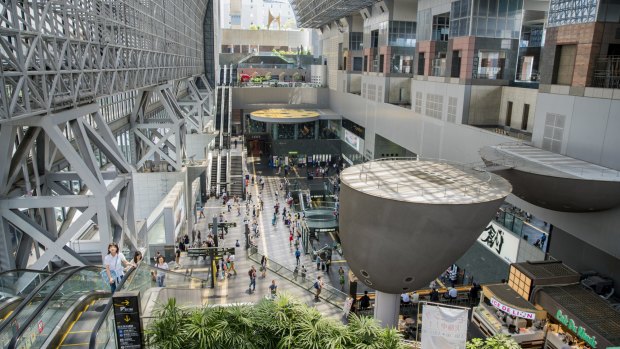This was published 1 year ago
What to do in Japan's train stations: Eat, drink, shop and enjoy

Kyoto Station. The sheer size, breadth and unfathomable efficiency of Japan's train stations is overwhelming.Credit: iStock
Prepare to be overwhelmed. This entire experience is going to be unlike any you have had in a train station. The sheer size; the breadth; the unfathomable efficiency.
There is no way to visit Japan and not go to a train station. This country runs on rails, from its world-famous shinkansen, or bullet trains, to its humble rural rattlers, to the squeezy Tokyo metro.
You're never far from a train station. And it will always be the best way to get around.
For the sake of this story we will concentrate on the main hubs, the key stations for high-speed inter-city travel. Every medium-to-large city has one – often several – from Tokyo to Kyoto, Osaka to Kanazawa, Sapporo to Fukuoka.
Give yourself time at these stations to get lost, because you will. They're just too labyrinthine and busy. Don't stress about this experience, because with time on your side you will get to where you need to be. Eventually.
And you need space to look around: there is so much to take in at a major Japanese train station. The attractions at these hubs are dictated by various Japanese cultural norms: the tradition of "omiyage", in which travellers bring back gifts for family and friends; the respect for regional difference; and the desire to have something good to eat.
These norms are reflected throughout each station. Each will be filled with shops selling small gifts reflective of the local area, regional specialties that often take the form of things edible or digestible in some way (this is Japan, after all).
There will usually be displays of local culture, too. In Hamamatsu, a city famous for musical instruments, there's a beautiful, transparent Kawai piano set up for people to play. Kanazawa Station is flanked by a huge wooden gate, similar to the torii gates found at this traditional city's shrines.
In Yuzawa, famous for sake, rail passengers can choose between 96 brands that are all dispensed in small tasting sizes from a wall-sized vending machine at the station.
And, of course, there is food for the journey. Many Japanese trains don't have restaurant cars; passengers tend to buy their meals before they board.
These meals are charmingly called "ekiben" – the "eki" meaning train station, and "ben" being short for bento. Train station bento boxes.
The concourses at major rail hubs are filled with ekiben stands selling everything from classics such as sushi, katsu-don (breaded cutlets with rice), and katsu-sandos (cutlet sandwiches), to whatever the local specialty is in that city or region.
Grab a box, buy a drink – a local beer is not only acceptable, but encouraged – make your way to the correct platform, and be on time. Because your train will be.
Sign up for the Traveller Deals newsletter
Get exclusive travel deals delivered straight to your inbox. Sign up now.